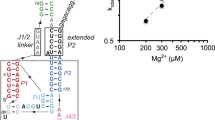Abstract.
Comparison of the most stable potential hairpins in the sequences of natural ribozymes with those in the randomized sequences has revealed that the hairpin loop energies are lower than expected by chance. Although these hairpins are not necessarily parts of functional structures, there is a selective pressure to diminish the destabilizing free energies of the hairpin loops. In contrast, no significant bias is observed in the stacking values of the most stable stems. In the ribozymes isolated in vitro the loops of potential hairpins are closer to random values, which can result in less efficient folding rates. Furthermore, the effects of kinetic traps seem to be more significant in the folding pathways of the in vitro isolates due to a potential to form stable stacks incompatible with the functional folds. Similarly to natural ribozyme sequences, the untranslated regions of viral RNAs also form hairpins with relatively low loop free energies. These evolutionary trends suggest ways for efficient engineering of improved RNA constructs on the basis of analysis of in vitro isolates and approaches for the search of regions coding for functional RNA structures in large genome sequences.
Similar content being viewed by others
Author information
Authors and Affiliations
Additional information
Received: 12 January 2001 / Accepted: 21 May 2001
Rights and permissions
About this article
Cite this article
Gultyaev, A., van Batenburg, F. & Pleij, C. Selective Pressures on RNA Hairpins In Vivo and In Vitro. J Mol Evol 54, 1–8 (2002). https://doi.org/10.1007/s00239-001-0010-4
Issue Date:
DOI: https://doi.org/10.1007/s00239-001-0010-4




